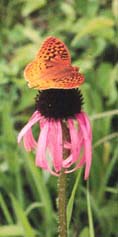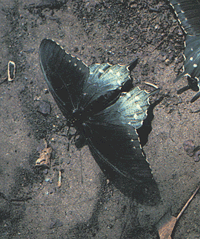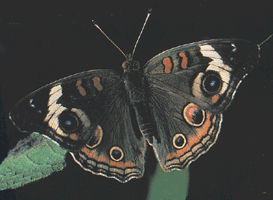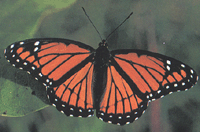Side by Side:
Butterfly Wings and Symmetry
(adapted from a lesson by Siri Hartsfield, Springfield, School District 186.)
 Objective:
students will understand the term symmetry (bilateral) as used in art and science by observing butterfly species' wings and the principles of coloration; then they will create and paint a mirror-image design of a butterfly's wings, based on a criteria described below, on a cutout poster board butterfly shape.
Objective:
students will understand the term symmetry (bilateral) as used in art and science by observing butterfly species' wings and the principles of coloration; then they will create and paint a mirror-image design of a butterfly's wings, based on a criteria described below, on a cutout poster board butterfly shape.
Regal
Fritillary
Copyright by Everett Cashatt
Grade
Levels: 3-6
Time Required: 20 minutes to look at butterfly images in the ISM Lepidoptera
Collection Online and other online images. 30-40 minutes to draw and paint
their design.
Materials:
- Computer with Internet
access
- Small drawing paper folded into 2-inch squares for sketching trial patterns
- Poster board (cut into large butterfly shapes,
scored lengthwise in half for later folding)
- Pencils
- Tempera paints, pans, water jars, brushes, towels
ISM
Online Resources:
https://www.museum.state.il.us/ismdepts/zoology/lepidoptera/
Motivation:
Students will view butterfly species wing patterns, noting the stripes, dots, and other patterns that appear in nature. They will also note the colors, which are related to habitat adaptation. They will discuss how the patterns are symmetrical and what effects that creates.
Symmetry
in Art: Finding the Line of Symmetry Lesson Plan.
https://www.tacoma.washington.edu/education/intel2001/Projects/math/krug1.pdf
Butterfly wings are bilaterally
symmetrical.
Where is the centerline of symmetry?
How are the patterns on one wing related to those on the other wing?
Talk about an example of two of butterfly species. (see examples below)
Task:
You are designing a butterfly wing pattern based on a principle of protective coloration.
The principles are:
1) Camouflage: the butterfly will blend in with its surroundings. It will look like what it rests and basks on - rocks, tree bark, flower petals, grasses, tree branch or leaf.
2) Startle Effect: the butterfly's wing pattern will startle a predator with its bright color or its large eyespots that make it look like a larger creature.

3) Mimicry: the butterfly's pattern will look like the pattern of another species that is known by predators to be noxious or poisonous.
*SEE THE INTERACTIVE ON PROTECTIVE COLORATION.
The Pipeline Swallowtail blends in.

The Buckeye startles its predators
 The Viceroy mimics the Monarch
The Viceroy mimics the Monarch
Photographs by Mike Jeffords
These images are from the Illinois Department of Natural Resources Illinois Moths and Butterflies Poster.
Procedure:
Choose one or more of the principles and design a wing pattern that fits it. The second wing will have an identical but reversed pattern.
Sketch your ideas for symmetrical patterns on the thumbnail-size squares of drawing paper.
Choose your favorite one, making sure it is symmetrical.
Transfer your design to poster board by redrawing the basic pattern onto their butterfly model.
Paint the pattern onto the butterfly and set it out to dry.
Presentation:
Butterflies can be displayed on a wall or a tabletop.
If the undersides are painted after the topside dries, the butterflies can be hung as mobiles.
Assessment:
Each student's artwork should demonstrate a bilaterally symmetrical pattern. Students should be able to verbalize the ways their design is symmetrical.
Illinois
State Board of Education Goals Addressed:
Visual Arts
25.A.1d: Identify the elements of line, shape, space, color and texture; the principles of repetition and pattern; and the expressive qualities of mood, emotion and pictorial representation.
25.A.2d: Identify and describe the elements of 2- and 3-dimensional space, figure ground, value and form; the principles of rhythm, size, proportion and composition; and the expressive qualities of symbol and story.
Science:
12.A.1b: Categorize living organisms using a variety of observable features (e.g., size, color, shape, backbone).
12.B.1a: Describe and compare characteristics of living things in relationship to their environments.
12.B.2b: Identify physical features of plants and animals that help them live in different environments (e.g., protective coloration).
Resources
to Read:
https://www.chebucto.ns.ca/Environment/NHR/monarch.htm
New Brunswick Naturalist. "Monarchs, Viceroys, and Queens: Who's the Real Pretender to the Throne?"
https://cgee.hamline.edu/ see/questions/dp_transformation/dp_trans_adapt_mimic.htm
"Mimicry and Protective Coloration."
https://www.fmnh.org/butterfly/selfpro_basic.htm
"Self-Protection: Camouflage and Mimicry."

